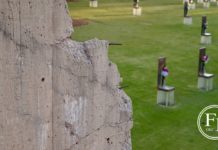Last Updated on December 4, 2016, 5:46 PM | Published: July 25, 2016
A local marketing firm has developed its own app that only 50 years ago would have been the stuff of science fiction. And leaders at the company have called the technology “a game changer” and “a big deal for our company.”
The free TrifectAR app, developed by Moore, Oklahoma marketing company Trifecta Communications, uses augmented reality and virtual reality technology to allow anyone with a smartphone or tablet to download it and view linked printed pages that seemingly come to life through the phone.
Augmented reality (AR) adds imagery to an object you are viewing much like Google Maps 3-D allows you to see dimensions of certain buildings on a map.
Virtual reality (VR) takes the viewer out of the real world they are in and gives a visual representation that they are someplace else. For example, one can view in 360 degrees the area around the pyramids of Egypt while sitting in a living room in Oklahoma.
Just released
Trifecta just released the app for download in June. Its AR and VR capabilities allow users to view extended content from within the app that adds a 3-D, video, or VR dimensional overlay to the flat representation of a printed page in front of the phone’s camera.
Content seemingly comes to life once a printed piece with the code is scanned. It can show a 3-D view of a photo and allow the user to manipulate the image simply by moving their phone in different directions.
The app can be programed to sync with business cards, political handouts, marketing literature or advertisements.
Founded in 2006 by CEO Brent Wheelbarger, Trifecta produces video and printed content for clients of all sorts. The company publishes the Moore Monthly, an alternative newspaper focused on Moore and surrounding communities. Ads that synchronize with the app are used in the publication.
Game changer
“This is a big deal for our company,” Wheelbarger told Oklahoma City Free Press. “It allows us to add a lot more value and content to work that we print for our clients and for Moore Monthly.”
He explained that they have always been in the video business, their first client being the City of Moore. They still produce a video magazine for the city’s public service cable channel.
But as they moved out into a broader field of marketing for other clients, they started paying close attention to experimental AR/VR technology.
“I really do believe that this is going to be a game changer,” said Rob Morris, director of special projects. “It’s going to be disruptive in the same way that the iPhone was.”
The company saw the potential when they started using a similar app developed by another company. It allowed them to experiment with the end result and how they would use it for their clients.
The first time they used the technology was in an ad campaign for a local bank in December 2014. Wheelbarger said that the client liked the outcome, and then others started wanting to use it as well.
But then in summer of 2015 that app’s company announced that they would no longer support it after the end of the year. That’s when Trifecta had their own code team start work on an app that they would own and continue to perfect over time.
That was the beginning of their TrifectAR app.
Possibilities
“I have to be careful because I’ll get on my soapbox and start preachin’ about AR, and the future,” Morris said.
He explained that AR technology will give journalism, instructional material and advertising a whole host of possibilities.
First demonstrated by Ivan Sutherland in 1968, AR has been in constant development since. A German technology group first found a way to use see-through AR on cell phones in 2004.
Morris recounted Trifecta’s first use of AR for journalism in their Moore Monthly publication.
They had a story about a Moore resident who raced a top fuel dragster, the fastest class in drag racing.
The cars are specially built from front to back in a long rail scheme. Anyone using the app could point their phone at the photo and then see an exploded view of the complex car and tap on call-outs around the illustration that explained the various parts further.
Currently, the Boy Scouts of America use TrifectAR app for training in their various badge manuals. Now scouts no longer have to settle for the flat instruction illustrations, but can use the app to see a 3-D view and increase their understanding.
Now that the app has been successfully put to use locally, Trifecta is deploying marketing staff in Little Rock, Tulsa, Dallas/Ft. Worth, Houston, Austin and San Antonio, Wheelbarger said.
NOTE: In anticipation of the roll-out of this site, we began to gather and write news through the course of 2016. To help our readers understand the context of this story, the date reflects when it was gathered and written. Free Press went online October, 2016.
Founder, publisher, and editor of Oklahoma City Free Press. Brett continues to contribute reports and photography to this site as he runs the business.








